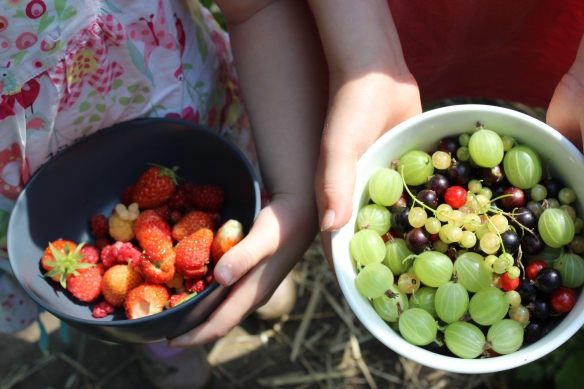PLANNING THE REFINE STAGE
Design – Produce your design. Revisit your boundaries and resources, are your plans realistic? It may be helpful to present your design in a visual format even if it is a non-land based design. How could you share your design with other people?
Practical tasks – How are you going to make your design happen? Make your implementation and maintenance plans. Do the work, make your design a reality and document the process.
Tweaks – Tweak the project as you progress.
ACTIVITY FOR THE REFINE STAGE
Design
The designing has been divided into three sections;
- Foraging in the local area
- Adding herbs and medicinal plants to my home garden.
- So what will I do with all these plants once I’ve grown or foraged for them?
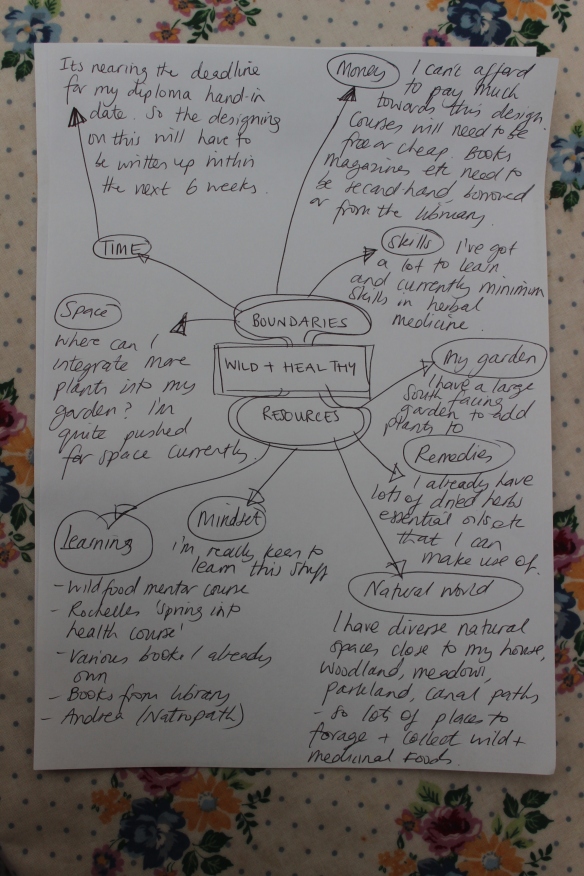
As per my planning, I began the design stage by looking back at my boundaries and resourses. I considered what I could use to make my designing quicker and easier. I decided I’d use annotated images taken from google maps for the local and garden mapping. I’d revist my previous garden design and use this as a base map on which to add my updated plans, thus saving me lots of time measuring and drawing another map of my garden.
- Foraging in the local area.
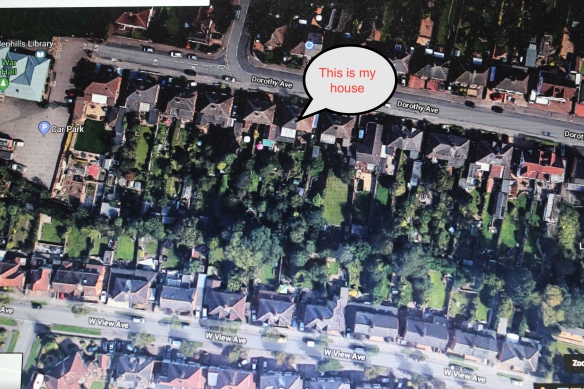
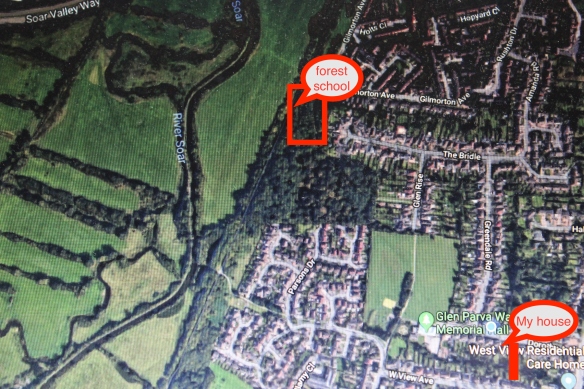
When I was designing my forest school business, it was important to me that the woods were near to my house. I got lucky by gaining permission to use parish council woodland that I can see from my house and walk to within a few minutes. You can see the locations from the map. I decided that this was the area that i’d use for the foraging element of this design.
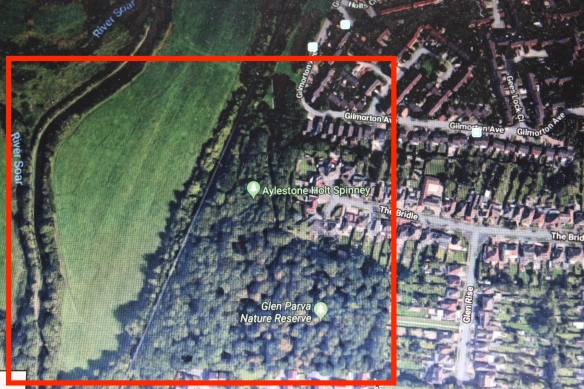
This shows the rough area in which I plan to forage. I plan to use the woods, meadow, park and canal side for my foraging because I am already a regular visitor to these places and they are so convenient.
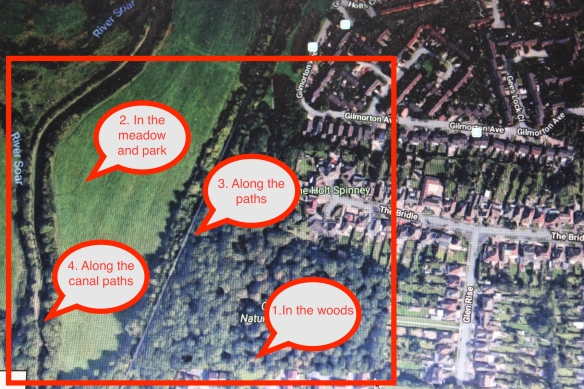
See the text below for details of what I have observed growing in the 4 areas specified and what I plan to forage for.
- In the woods – Wild garlic, garlic mustard, rocket, nettles and elder.
- In the park and meadow – Elder, roses, garlic mustard, yarrow and nettles
- Along the paths – Elder, roses, nettles and garlic mustard
- Along the canal paths – Elder, roses, nettles and garlic mustard
2. Adding herbs and medicinal plants to my home garden.
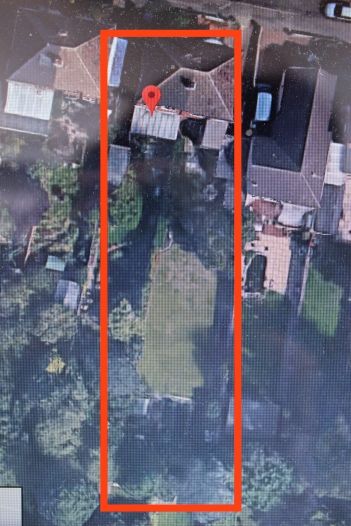
This map shows an aerial view of my garden and how it sits with the neighbouring properties. The length of the garden is approximately 125 foot and the width varies from 28-24 foot along the boundary.
To save time and effectively use resources, I have re-used the map of my garden that I created previously in Design 2 Food from my garden. I Have used this as my base map and added overlays for this design.

This is my original map of my whole garden that I drew up in 2014
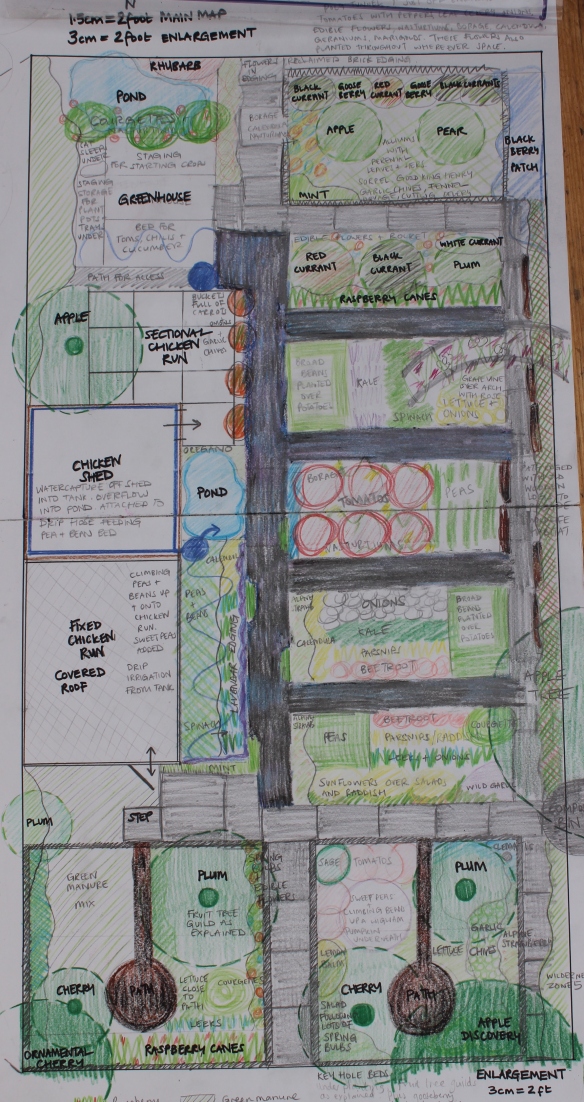
This map shows an enlargement of a section of the garden that I was re-designing in 2014. This map is useful for me again as most of my current designing will again take place in this area.
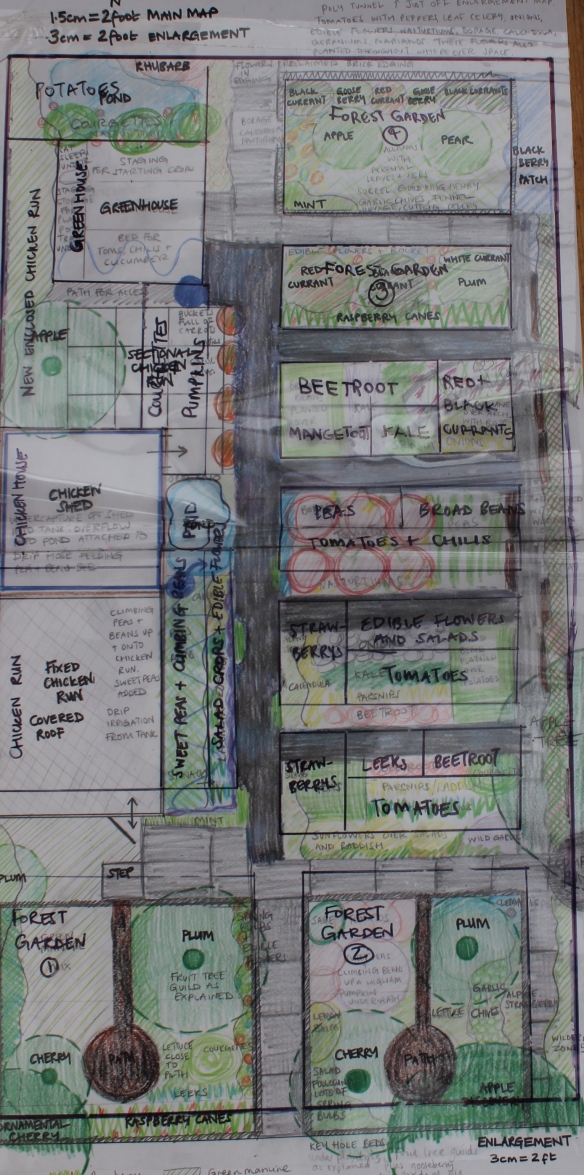
This map shows the tweaks that I’d planned for my garden when I updated the design in January 2015.
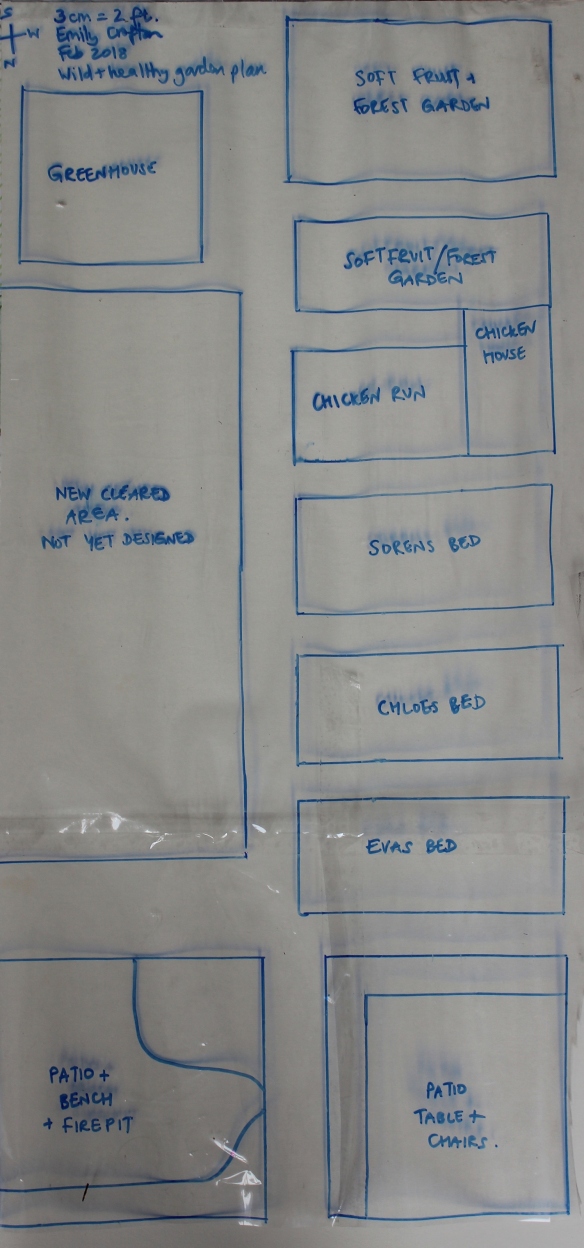
This simple base map was created for this design and shows the major changes that have taken place in this area of my garden since my tweaks in 2015.
In summary, these are the changes that I’ve made to date before this particular design;
1. The two large beds at the bottom of the map have been partially removed and replaced with patios. They are lovely sunny spots where we enjoy resting, relaxing and cooking over the campfire. Boarder beds remain as do the large overhanging fruit trees.
2. The children now each have their own raised bed in which to plan whatever they like. All three beds have some perennial plants that are thriving and the kids plant annual flowers and veg crops around these.
3. One of the raised beds had been removed and replaced with a chicken house and attached run. We only have three chickens now, so they need less room.
4. The large chicken shed and runs have been removed. This has opened up a large area that I have not yet planned what to do with. it may become a lawned area or maybe an outdoor kitchen or maybe a play area for the kids. This is another design in itself.
5. The soft fruit/ forest garden beds are doing well. We harvest lots of fruit from them now and I plan on continuing to work on making them even more productive over the coming years.
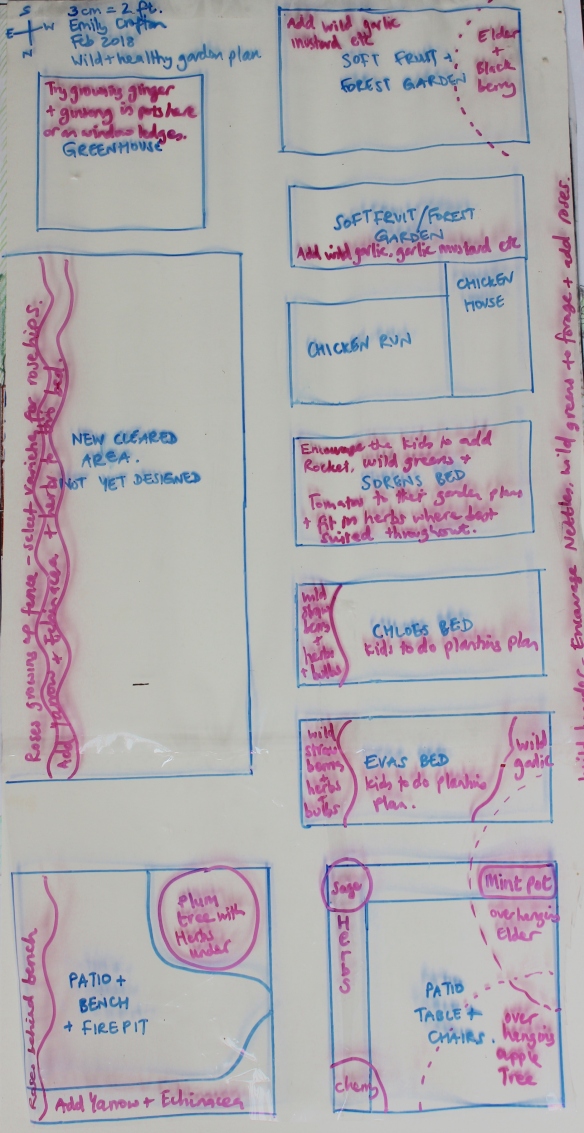
This more detailed overlay shows where I plan to put the plants I’ve decided to use for this design. I’ve kept my plans quite loose at this stage, especially in the kids beds as I want them to have some input into designing these beds. I will also be adding plants to areas of my garden not included on this map. I will be adding pots of herbs in areas close to my house more wild garlic, garlic mustard, rocket and nettles around the edges of my garden, especially at the north more wild end and I will be adding Echinacea and yarrow to my flower border on the east boundary.
3. So what will I do with all these plants once I’ve grown or foraged for them?
Part of my design is to make my own homemade herbal remedies using the plants that I’ve chosen. Last year while I was in the thinking/ researching stages for this design, I made a few remedies. Some were made at home and some on a day course I went on about making herbal oils and balms. I’ve been using them on myself and my family over the winter months and enjoying the process of experimenting and learning.
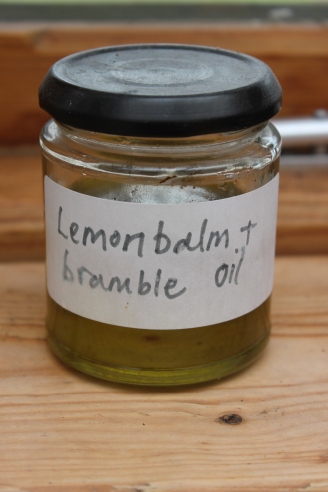
I made a lemon balm and bramble oil which is good as a salad dressing or a spoonful added to hot water or herbal tea. It’s good for a sore or irritated throat.
.
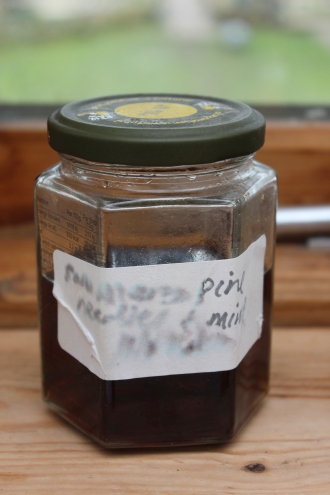
I made this oil with rosemary, pine needles and mint (Unfortunately the label is blurred now) It’s for a chesty cough.
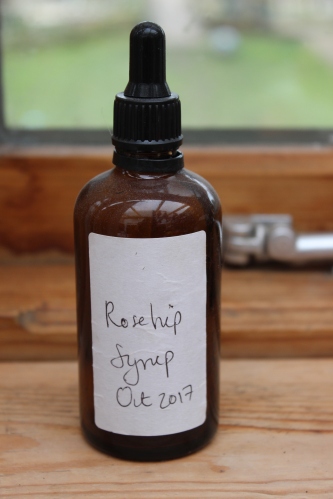
My kids and I foraged for rosehips in the autumn and made loads of this rosehip syrup. Its delicious and we’ve been using it all winter when we feel under the weather.
.
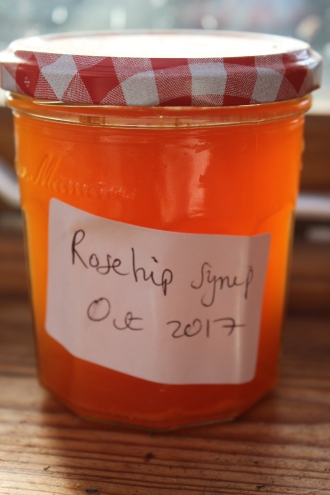
We made extra rosehip syrup to give away to friends and family , check out the beautiful colour!
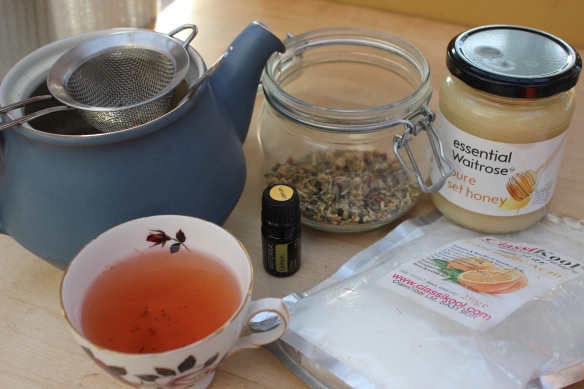
When I was ill with the flu last month it was the perfect opportunity to try out some of my planned remedies. As I was early in the design stage, I decided to start by only using remedies that I already had around my home. (using the permaculture principle of small and slow solutions) I used my stash of dried herbs to make herbal teas to help with sleep and immunity. (recipes below) I drank lots of lemon, honey and ginger tea. I’d normally add a shot os whiskey too, but I didn’t on this occasion as i was doing ‘dry-january’. I put a spoonful of pro-biotic and vitamin C powders into my drinks. I used lemon and oregano essential oils and a blend called ‘On-guard’ rubbed into my feet, my chest and added a drop in my drinking water twice a day.
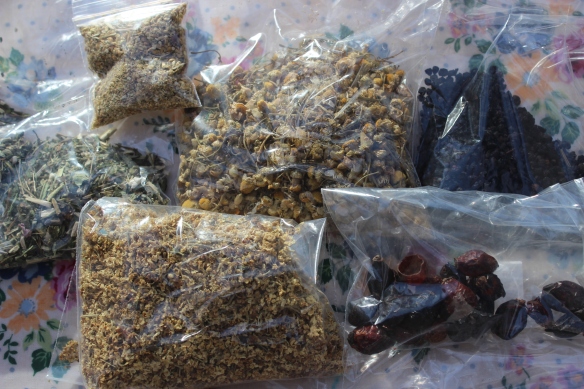
I made ‘immuni-tea’ herbal blend using elderberries, rosehips, chamomile, elderflowers and echinacea. This recipe is from a book called ‘Witch’ by Lisa Lister.
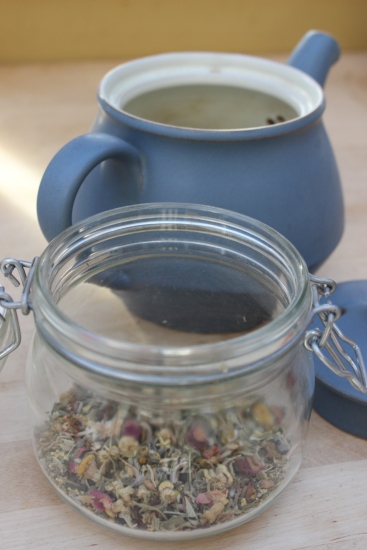
I made a ‘sleepy tea’ blend to help with my broken nights. This included lavender, chamomile, rose and Echinacea.
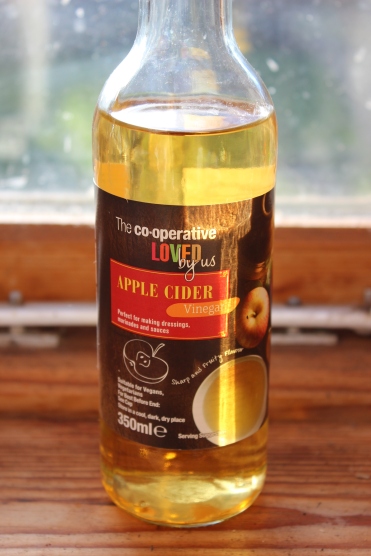
I drank a spoonful of apple cider vinegar first thing in the morning with a big glass of water. I actually really enjoy the taste and find it helps me to have an appetite wich otherwise can be low during illness.
Other remedies I am planning on trying out;
I am planning on making Elderberry syrup next autumn using this recipe here
I will also make Rosehip syrup again using a recipe like this one here
I will make lemon honey ginger drinks like this simple recipe here
I will try the flu bomb essential oils remedies as roller balls and capsules like this one here
I will make lots of wild garlic pesto and will add other foraged green in to a recipe similar to this one
I will be experimenting with a new plant in my garden, Yarrow and using it for remedies like the one here
Practical tasks – Implementation and maintenance plans
I found that when I wrote my goal list, it turned into an implementation plan! So you can view that against the end of this post here.
I turned my goals list into an implementation plan by re-formatting it into monthly chunks. This makes it more clear to see what needs to be done and the timescales involved. I have printed out a copy of this table and am ticking off each task as it is achieved.
| MONTH | TASKS TO DO |
| FEBRUARY | I will draw up a plan of how to add my chosen plants into my home garden. |
| I will prune my elder | |
| I will walk the local area to look at what is growing and talk with people with local knowledge. | |
| I will look at existing maps of my area and draw my own version showing where to find the plants I want to forage for. | |
| I will look at prices for all items to purchase and decide on the most cost-effective way to make my purchases. | |
| I will complete the write up for this design | |
| MARCH | I will look in plant and seed catalogues and order my chosen plants and get ready to start them off in the spring once the weather has improved. |
| I will research herbal remedies and make decisions about what I’d like to try making this year. | |
| I will find out more about using yarrow and see if it is growing locally or add it to my garden. | |
| I will find some good recipes for yarrow remedies | |
| I will make my food purchases and include the food items in our diet | |
| I will use the oils in preventative ways and as treatments when needed | |
| APRIL | I will add plants as planned in my design from April onwards |
| I will leave a patch of nettles at the end of my garden. | |
| I will encourage the wild garlic, garlic mustard and rocket growing wild in my garden. | |
| I will harvest wild greens at the correct time and add them to our diet as fresh greens, pestos and as cooked greens. | |
| MAY | I will forage for spring greens, nettles, wild garlic, garlic mustard. |
| JUNE | I will harvest yarrow |
| SEPTEMBER | I will harvest elderberries and process to make syrup |
| OCTOBER | I will harvest rosehips after the first frost and process them to make syrup. |
I’m not really at the stage of being ready for a maintenance plan as yet as I still have to do the implementation. So this will be addressed later on in the process.
Tweaks – I have already made some initial changes to my original plans. As I’ve got further along with the process, I’ve tweaked my ideas more to be more realistic about what time and space I have available to me.
On reflection, I decided maybe not to grow the following;
- Eucalyptus (this is a non native tree, so not ideally suited to my back garden. I think that using eucalypts essential oils will be a better option)
- Echinacea and yarrow ( herbal remedies will be a better option but I may add them to my garden anyway for their beauty alone)
- Leafy greens (My chickens will eat these before I do, adding them to my weekly veg box order will be a better option)
- I’m still not sure about growing tomatoes either as when I’ve grown these for the last few years, I have found them to be a lot of work and I’ve lot almost the entire harvest to blight at the last-minute. Once blight is in your ground, it’s very hard to grow the same plant type again without succumbing to it again.
As this project is an ongoing project that has not yet been implemented, I expect there will be lots of further tweaks to my design in the future.
